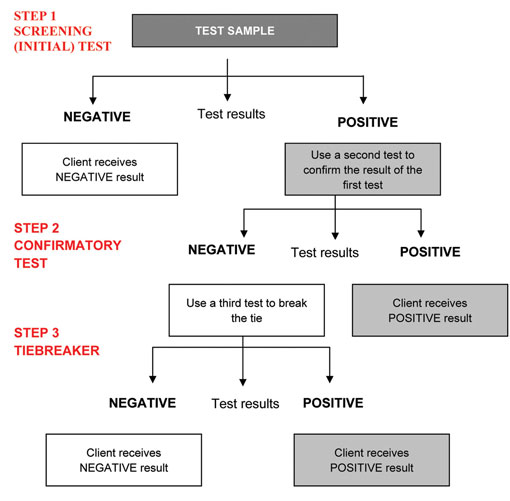24.6 Step 4: How to perform a rapid HIV test
Both HIV-1 and HIV-2 can be detected by rapid HIV tests. The advantages they offer over other testing technologies is that they can be performed on small amounts of blood, the results are available within minutes, and they can be done in a person’s home or at a health post.
In Ethiopia we use three types of rapid HIV test kits. They are known as:
- KHB (a trade name)
- STAT-PAK (a trade name)
- Uni-gold (a trade name).
The logical step-by-step procedure for using the three rapid test kits to determine an individual’s HIV status is called the HIV testing algorithm (Figure 24.3).
The algorithm uses three types of tests — the screening test, the confirmatory test, and a tiebreaker. The screening test is the first test in the sequence. The confirmatory test is used to confirm a positive result if the first test is positive. A tiebreaker is the final test which is done when there is a difference between the screening and confirmatory test results. In Ethiopia, we use KHB as a screening test, STAT-PAK as a confirmatory test, and Uni-gold as a tiebreaker.
If a test is non-reactive when using the KHB test kit, we do not need to do another test and we report it as negative — the individual tested is HIV-negative.
If the test is reactive with KHB, we need to perform a second test using STAT-PAK to confirm the result. If the test is also reactive with STAT-PAK, we report it as positive — the individual tested is HIV-positive.
Reactive means the test yielded a positive result. A non-reactive result is a negative result.
If the test is reactive with KHB, but non-reactive with STAT-PAK, we need to do a tiebreaker test (Uni-gold). If the Uni-gold is non-reactive, we report the result as negative. However, if the Uni-gold is reactive, we report the result as positive.
After how many tests do you notify the client that the outcome of the testing process is that he or she is HIV-positive?
You should not report a positive HIV test result after just using one test. At least two different rapid tests have to be reactive before you report a positive result.
The following sections provide guidance on how to conduct a rapid HIV test.
24.5 Step 3: Obtaining a specimen for HIV testing

